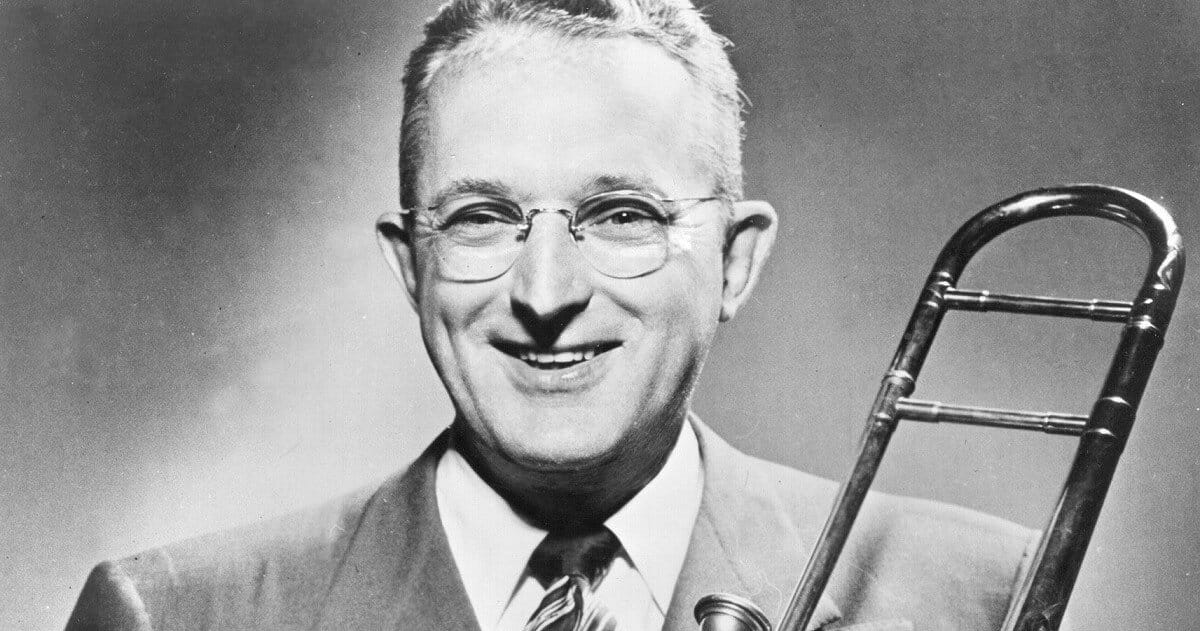Are you a fan of the swinging tunes of the Big Band Era? If so, you’ll definitely want to dive into the captivating story of Tommy Dorsey, the legendary trombonist who left an unforgettable mark on American music. Get ready to uncover the secrets behind his magical trombone, the tragic circumstances surrounding his untimely death, and the inside scoop on how Frank Sinatra became a part of his legendary band. We’ll also explore his timeless melodies and guide you to his final resting place. So, sit back, relax, and join us on this fascinating journey into the life and legacy of Tommy Dorsey!
Facts About Tommy Dorsey
Tommy Dorsey, a true legend! Born Thomas Francis Dorsey, Jr. in Pennsylvania in 1905, this musical icon seemed destined for greatness. While some kids gravitated toward toys, young Tommy was captivated by music. He initially explored the trumpet but ultimately found his calling with the trombone.
Fast forward to 1935, Tommy wasn’t just playing music; he was leading it. He formed his own orchestra, and their tight, polished arrangements quickly became the gold standard of the swing era. Hits like “I’ll Never Smile Again” and “Marie” soared to the top of the charts, propelled by Tommy’s velvety smooth trombone playing and captivating vocals.
Tommy’s talent attracted a constellation of stars. He collaborated with some of the most celebrated vocalists of the time, including Frank Sinatra, Jo Stafford, and Connie Haines, creating musical magic that continues to resonate with audiences today.
Beyond his role as a bandleader, Tommy was also an innovator, constantly pushing the boundaries of big band music. He crafted new sounds and helped redefine the genre, solidifying his place as a musical pioneer.
Tommy Dorsey’s journey wasn’t confined to leading a band. He also enjoyed a successful solo career, showcasing his individual artistry and proving his star power. His legacy was further cemented in 1982 when he was inducted into the Big Band and Jazz Hall of Fame, a testament to his enduring impact on the world of music.
Eager to delve deeper into the specifics of Tommy Dorsey’s life? Explore the milestones that shaped this musical icon’s remarkable journey in the table below:
| Milestone | Year |
|---|---|
| Birth in Pennsylvania | 1905 |
| Formation of Dorsey Brothers Orchestra | 1935 |
| “I’ll Never Smile Again” hits the charts | 1937 |
| The Tommy Dorsey Orchestra is born | 1940 |
| “Marie” takes the airwaves by storm | 1942 |
| Tommy’s life hits the big screen in “The Strip” | 1950 |
| Passing in Greenwich, Connecticut | 1956 |
| Posthumous induction into the Big Band and Jazz Hall of Fame | 1982 |
Tommy Dorsey’s story is a powerful reminder that music has the extraordinary ability to move us, inspire us, and even shape entire generations. Whether you’re a lifelong fan or new to his captivating melodies, take a moment to appreciate the immense talent and legacy of this true musical trailblazer.
What Instrument Does Tommy Dorsey Play?
While Tommy Dorsey dabbled with both the trumpet and trombone in his early years, it was the trombone that truly captured his heart and became his signature instrument.
Tommy’s trombone playing was renowned for its exceptional smoothness and lyrical quality, earning him the moniker “The Sentimental Gentleman of Swing.” He possessed an uncanny ability to make the trombone sing, breathing life and emotion into every note. His virtuosity on the instrument led many to consider him a true master, capable of weaving captivating stories through his music.
Some music historians suggest that his early experiences with the trumpet may have contributed to his unique approach to the trombone, helping him develop a distinctive sound and technique. It’s intriguing to consider how our diverse experiences can shape our artistic expression.
While the trombone may have been his primary instrument, it’s also worth noting his proficiency on the trumpet. His ability to excel at both instruments underscores his natural talent and dedication to his craft.
So, the next time you find yourself enchanted by a Tommy Dorsey tune, pay close attention to the trombone. You’ll quickly understand why he remains a revered figure among trombone enthusiasts and is still hailed as one of the all-time greats. His playing exudes a passion and soulfulness that continues to captivate listeners.
What Trombone Did Tommy Dorsey Play?
Tommy Dorsey’s musical partnership with his trusty Schilke 42B trombone, often referred to as the “Dorsey model” by aficionados, played a pivotal role in shaping his signature sound. This wasn’t just any instrument; it was an extension of his musical voice.
So, what made this trombone so special? Imagine a chef’s favorite knife – that’s how Dorsey viewed his Schilke 42B. This particular model boasted a lightweight and maneuverable design, with a sleek profile that likely felt like a natural extension of himself. The mouthpiece, or “cup,” featured a relatively shallow design, which some speculate contributed to Dorsey’s bright, clear tone. The “bore,” the inner tube of the trombone, also played a crucial role. Dorsey’s trombone had a specific bore size of 0.905 inches. While seemingly insignificant, this detail contributed to his signature sound – a sound that was both powerful and capable of cutting through the sonic landscape of a big band.
The trombone served as Dorsey’s voice, and the Schilke 42B amplified that voice with clarity and power, allowing his music to reach the depths of his listeners’ souls. It wasn’t just about the notes themselves; it was about the unique way his instrument allowed him to express those notes. This special trombone transcended its role as a mere tool; it was a collaborative partner in creating the iconic sound that defined Dorsey’s band and left an enduring legacy on the swing era.
What Happened to Tommy Dorsey?
Tommy Dorsey’s sudden passing in 1956, at the age of 51, shocked the music world. The official cause of death, as determined by the medical examiner, was accidental choking. It was reported that he choked after a large meal, with his own vomit cited as the cause – a tragic and unexpected end for a musician at the height of his powers. Despite some speculation and rumors circulating at the time, no evidence of foul play was ever found.
However, it’s important to acknowledge that the passage of time and advancements in medical knowledge and investigative techniques might offer different perspectives today. While we respect the findings of the time, it’s natural for questions to linger, especially when someone of Dorsey’s stature passes away under such circumstances.
In the wake of his passing, Tommy’s brother, Jimmy, stepped forward to keep their musical legacy alive, ensuring that the Dorsey Brothers’ sound continued to grace the airwaves. It’s a testament to the enduring power of family and the timeless appeal of their music. Even today, Tommy Dorsey’s soulful trombone solos and the band’s infectious energy continue to resonate with listeners, a testament to their lasting impact on the world of music.
Tommy Dorsey’s story reminds us that life is precious and often fleeting, even for those who shine brightest. However, his music continues to uplift and inspire, proving that some legacies truly transcend time.
Interested in exploring further? Delving into archival newspaper articles and biographies from the time can offer valuable insights into the life and impact of Tommy Dorsey and the circumstances surrounding his passing.
When Did Sinatra Join Tommy Dorsey?
Frank Sinatra’s tenure with Tommy Dorsey’s band marked a pivotal chapter in music history. By January of 1940, Dorsey had already earned his reputation as “The Sentimental Gentleman of Swing,” leading one of the most sought-after bands of the era. When he crossed paths with a young Sinatra, who was making waves with Harry James’ band, Dorsey recognized his star potential and decided to take a chance on the up-and-coming vocalist.
This decision proved to be a stroke of genius. Sinatra’s smooth, velvety vocals added a new dimension to Dorsey’s music, and together they churned out hit after hit, recording over 80 songs together. Their collaboration on “I’ll Never Smile Again” propelled the song to the top of the charts, where it remained for an impressive 12 weeks, solidifying their status as a musical force to be reckoned with.
Sinatra’s time with Dorsey served as a launching pad for his extraordinary career. He blossomed from a talented vocalist into a bona fide star. However, Sinatra was also ambitious and eager to forge his own path, to develop his own unique sound. In September of 1942, after two years of making musical history with Dorsey, Sinatra decided to embark on a solo career.
History suggests that this parting of ways may not have been entirely amicable. There were whispers of strained relations between Sinatra and Dorsey, a common occurrence in the often-turbulent music industry.
As we all know, Sinatra went on to achieve legendary status, becoming a global icon. However, his time with Dorsey played a crucial role in his development, providing him with invaluable experience, exposure, and a collection of incredible songs that would become staples in his repertoire.
Dorsey’s story, however, didn’t end there. He continued to lead his band, showcasing his exceptional trombone playing, and shaping the sound of an era. It’s a testament to his enduring talent and influence on the world of music.
What Songs Did Tommy Dorsey Write?
While Tommy Dorsey was a musical powerhouse, known for his trombone mastery and leadership, he wasn’t primarily a songwriter. His band, brimming with talented musicians, delivered a string of chart-topping hits like “Marie” and “I’ll Never Smile Again,” but Dorsey’s name doesn’t appear on the songwriting credits for many of these popular tunes.
Think of Dorsey as a master interpreter, a conductor of musical energy. He possessed an uncanny ability to take a song, infuse it with his signature trombone sound, and guide his band to breathe life into the music in a way that resonated with audiences and lured them to the dance floor.
While Dorsey may not have penned many of the songs his band made famous, his influence on their success is undeniable. He was a visionary bandleader and a master of his craft, shaping the sound of an era.
Where Is Tommy Dorsey Buried?
Tommy Dorsey, “The Sentimental Gentleman of Swing,” rests in Kensico Cemetery in Valhalla, New York, a serene setting just north of the bustling metropolis.
Kensico Cemetery is expansive, but locating Tommy’s final resting place isn’t difficult. Head to Section 41 of Kensico Gardens, and you’ll find his grave. The inscription on his tombstone reads simply “The Sentimental Gentleman,” a fitting tribute to his iconic theme song, “I’m Getting Sentimental Over You.” It’s a poignant and respectful homage to the man and his music.
Fans of the big band era often make pilgrimages to Dorsey’s grave, paying their respects and reflecting on his musical legacy. His music continues to touch hearts, and his final resting place provides a space for quiet contemplation.
If you ever find yourself in the area and wish to visit, you can even join a guided tour of the cemetery. It’s an opportunity to learn more about Tommy Dorsey’s life and career and to see where he rests among other notable figures.
For those intrigued by stories of innovation and determination, check out the extraordinary journey of Pham Nhat Vuong. Music lovers eager to explore the blues will enjoy discovering the fascinating facts about Sonny Boy Williamson II.
- SYBAU See You Baby Meaning: Gen Z Slang Evolves - July 1, 2025
- Unlock Your Inner Youth: Lifestyle Secrets for a Vibrant Life - July 1, 2025
- Decode SYBAU Meaning: Gen Z Slang Explained - July 1, 2025







1 thought on “Unveiling the Swinging Legacy: Uncovering Facts About Tommy Dorsey”
Comments are closed.